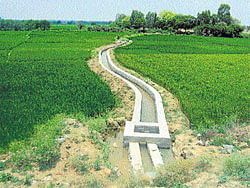
Farmers of Nallur in Kolar district’s Mulabagal have served as excellent role models for farmers in other regions to emulate. The Kolar region is known for its arid landscape and depleted water resources. And yet, farmers have raised paddy under the System of Rice Intensification (SRI) method of cultivation on 97.5 acres of land. As many as 106 farmers have gone on to participate in this paddy cultivation experiment. They have used fewer resources, less water and seeds and have managed to reap a rich harvest. As many as ten strains of paddy have been grown on their land. Farmers from nearby villages have been flocking to this stretch of land to take in the lush greenery of the paddy fields.
After taking up this method of cultivation, Nallur’s farmers are expecting a 30 to 40 per cent higher yield.. Mulbagal taluk has always set an example for other taluks when it comes to conserving natural resources and safeguarding their tanks, canals and other water bodies. This time, they have set a new example by way of their paddy cultivation.
The 106 farmers were trained to take up this method of cultivation as part of the Jalasamvardhane Project, and under the guidance of experts at the Agriculture University in Bangalore and Nallur’s Lakshmivenkateshwara Tankwater Users’ Association. These farmers have also successfully faced the challenge of shortage of agricultural labourers.
Under the traditional method of paddy cultivation, these farmers used a lot of water, but the yield would show no improvement. Earlier, seeds were also sown in an unscientific manner. A lot of chemical fertilisers were being used on the crops. But, thanks to the SRI method, all these resources have been conserved. It has also dispelled fears that if traditional methods are not used, there might be crop losses.
Ten varieties of paddy including NLR Tallahamsa and IR64 have been raised. Because water is supplied to the fields once in five days, and because a specific volume of water is channelised into the fields, at least 40 per cent of water is being conserved. Also because paddy is sown in a row, they will get adequate light and water.
As part of the traditional method, as many as 30 to 35 kgs of seeds are required for sowing. But under the SRI method, a mere eight-ten kg will suffice, explains Agriculture University’s Gubbaiah. District Incharge Secretary and Minor Irrigation General Secretary P N Srinivasachari suggested to the farmers to sow seeds on a bigger scale, rather than conduct the experiment on a mere four-five cres of land, where the yield may not be as high as expected.
“Earlier, we would sow seeds in a haphazard manner, and channelise a lot of water into the fields. Labourers would spend a lot of time on sowing.Today, we’ve saved on all that,” says Bangaramma, a farmer. “Though the SRI method has been followed in other places, this is the only instance in the State where it has been taken up on such a large-scale.
“Nallur’s farmers have co-operated with us to make it a success,” explains Agriculture University Convenor Eshwarappa.